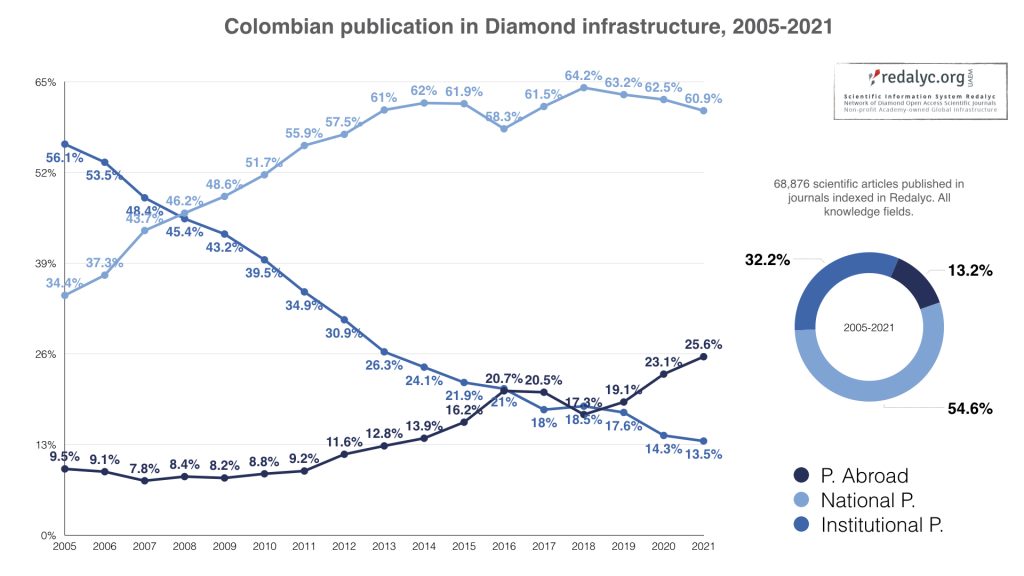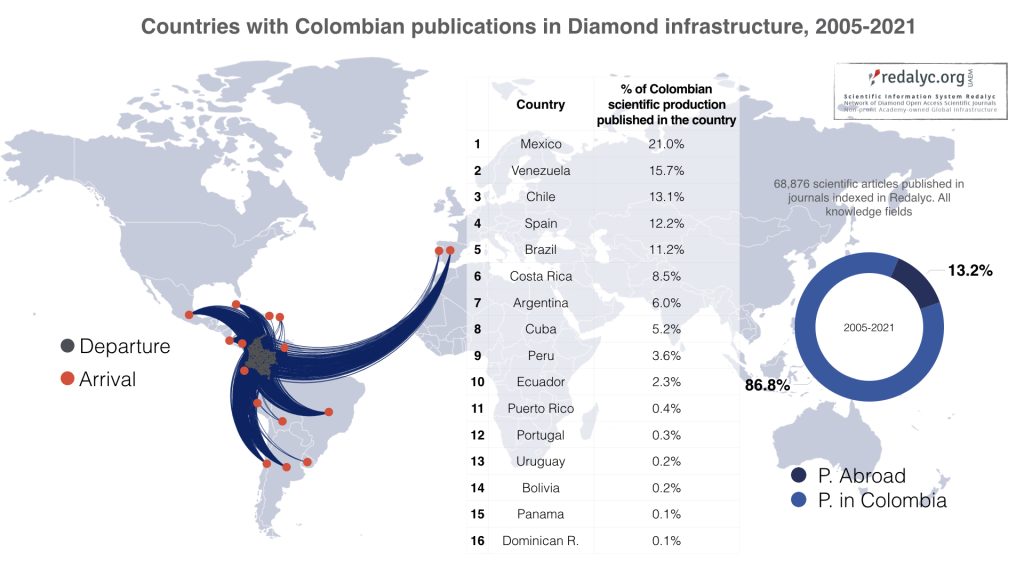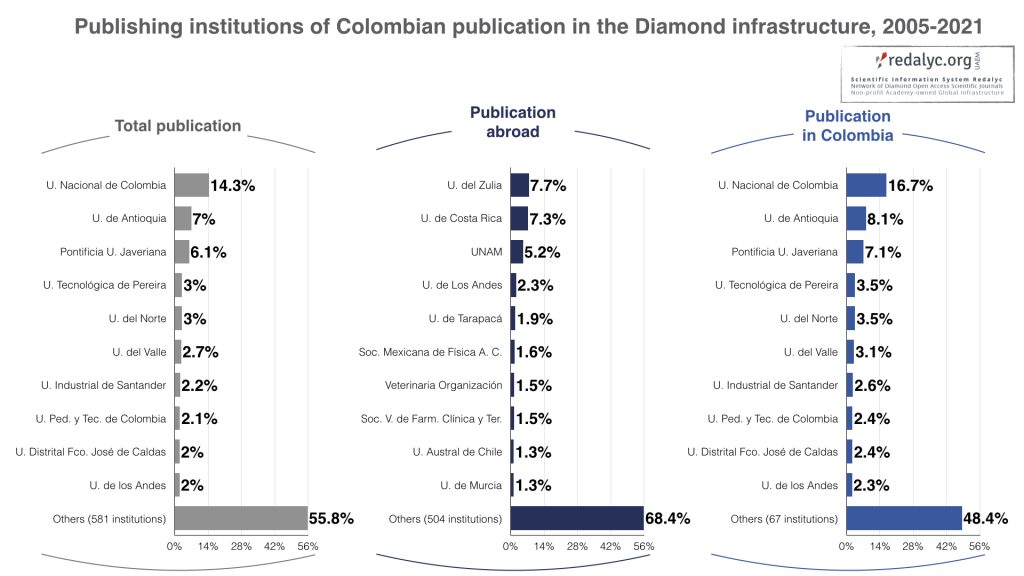THE CONTRIBUTION OF THE DIAMOND PUBLICATION IN COLOMBIA: MAKING VISIBLE THE INVISIBLE

Sheila Godínez-Larios
Universidad Autónoma del Estado de México
Colombia’s publication from Colav’s point of view
The CoLav (Colaboratorio de Vinculación para las Ciencias Sociales Computacionales y las Humanidades Digitales) of the Universidad de Antioquia, Colombia, published in september, 2020 the valuable text “Identificación de pagos de APC por parte de las instituciones de educación superior (IES) colombianas”, derived from the agreement between the Universidad de Antioquia and Consorcio Colombia represented by Consortia.
From the point of view of commercial publishing, Open Access is gradually shifting the payment for access towards publication, either for evaluation, review, processing and/or publication; a mechanism called APC (article processing charges). This modification in commercial publishing is mainly driven by Plan S, the Open Access strategy of the main science funders in Europe.
In this context, the rigorous and detailed work of CoLav had the aim to “calculate the APC costs assumed by Colombian universities, identify the type of access to publications made in the last 10 years (2009-2019), and other derived analyses” (CoLav, 2020: 8). Among its findings it highlights:
- Between 2009 and 2019, Colombian institutions have published 124,794 works, taking nine information cores as reference1. The documents from which the author of correspondence could be identified, specially from a Colombian institution and participant of the Colombian Consortium, represent 27% (33,682).
- The documents come from 60 Colombian institutions and have been published in journals from 2,783 publishers. 28.5% of Colombia’s scientific production has been published in 3 publishers: Elsevier, Springer and U. Nacional de Colombia.
- The main language of publication is English (69.07% of the documents), followed by Spanish (26.18%). Only 3.64% of the documents respond to a multilingual scheme (English and Spanish).
- 39% of Colombia’s scientific production is under a paywall.
- Between 2009 and 2019, Colombia has paid USD 10,900,808 in APC and this represents an expenditure that has multiplied by 15 in 2019 with respect to 2009. In turn, the cost per publication, from the Colombian experience, has become more expensive: it has gone from USD 1,060 to USD 1,493 on average (CoLaV, 2020).
The contribution of the Diamond Publication in Colombia
The study by CoLav was carried out in a context where coming to any transformative agreement by Colombia was just a possibility. A little more than a year later, on December 17, 2021, Consorcio Colombia announced the signing of a set of transformative agreements with Elsevier, Springer Nature and Taylor & Francis.
Institutions that generate scientific knowledge and/or finance scientific research are currently concerned about the advance of commercial publishing, specifically, where APC is promoted as a condition for opening academic content. As a result, analyses of cost-benefit, payment capacity, cost maximization, etc. have become recurrent, aimed at diagnosing the financial capacity of institutions to face the “new” dynamics of commercial publishing and, based on this, to negotiate and enter into transformative agreements with publishing houses2.
However, this concern of institutions and consortia is omitting the diagnosis of their performance in other circulation of knowledge models such as the Diamond publishing model. In this context of global and regional concern, the purpose of this work is distinct, and it has the aim of highlighting something that seems to have been taken for granted. This work aims to show, in general, the contribution that the Diamond publication does to the dissemination of scientific knowledge generated by Colombia, a model that has been assumed and omitted in the diagnoses of its performance in academic publication.
Unlike the study conducted by CoLAv, the brief analysis presented here is not exhaustive, but considers only one infrastructure —perhaps the only one— that exclusively indexes Diamond journals (without APC), the Redalyc Scientific Information System. Redalyc has evolved from an Ibero-American infrastructure with emphasis on Social Sciences and Humanities, to a global Diamond Open Access infrastructure; it currently indexes around 1,500 journals. The information on the publication of Colombia in the Diamond infrastructure is available on the Redalyc3 website. Based on this information, it was possible to present this diagnosis.
Between 2005 and 2021, Colombia has published 65,876 scientific papers in which at least one author with affiliation to a Colombian institution is identified. The indicators shown derive exclusively from peer-reviewed writings, although Redalyc identifies a total of 78,160 documents published by Colombia that include editorials, reviews, interviews, or other types of writings, as well as works prior to 2005.
The 65,876 scientific articles published derive from 158,171 forms of author with affiliation to 2,752 Colombian institutions. These were published in 1,207 Diamond journals from 591 publishing institutions (77 Colombian y 514 foreign) from 17 countries4; 52.4% of papers correspond to scientific production of Social Sciences, Art and Humanities, while 47.6% correspond to Natural and Exact Sciences.
13.2% of Colombia’s scientific production in Diamond journals was published abroad and shows a growing trend, that is, foreign journals host more and more scientific publications from Colombia: in 2005, 9.5% of Colombian production was published abroad, while in 2021 this volume increased to 25.6%. Publication in Colombian journals represents 54.6% and publication in journals of the authors’ own institution is 32.2%, but with a sustained contraction. This aspect shows that it is mainly the Colombian journals that have sustained the communication of scientific contributions from this country throughout the 17 years of the study.

Of Colombia’s publications abroad (13.2% of the total published), it should be noted that these have been mainly in Latin America: in Mexico, Venezuela and Chile, practically half (49.8%) of the scientific articles sent abroad have been published.

If we look at the total publication in Colombia, it is noteworthy that the publishing institutions where most publications have been made are all Colombian institutions, all of them universities: 10 Colombian institutions have published 44.2% of the country’s production (see the gray bars in the figure). On the other hand, if foreign publications are considered exclusively, Latin American institutions such as the U. del Zulia, Venezuela, and the U. de Costa Rica stand out as the foreign institutions that have published the largest volume of Colombian scientific production. And finally, if only publication within Colombia is considered, it is possible to identify the national institutions that have sustained the Diamond publication of Colombia in 17 years of study: out of 77 institutions with national publications, 10 have published 51.6%.

In turn, in the scientific production of Colombia identified from the Diamond infrastructure, the percentage of documents with Spanish as the first language represents 87.1%, while the percentage of documents with English as the first language represents 12.3%; both sets have a second language of publication. This contrasts with the 26.18% in Spanish and 69.07% in English of the publications analyzed by CoLav5, and shows the relevance of the knowledge published in each publication model. What are the possibilities of use and local appropriation of the knowledge if the language of publication hinders or facilitates its understanding?
A final line from which to characterize the contribution of Diamond publishing in Colombia is the use of scientific production: from Redalyc it is possible to identify a total of 70,643,084 downloads between 2013 and 2021 to the Colombian scientific production published between 2005 and 2021, which implies an average of 7.8 million downloads per year.
Making visible the invisible
This could lead to two elements in the Colombian science communication strategy:
- If Colombia were to consider eventually investing in the Diamond publishing model, it could establish two strategies in this regard: participate in the financing of the global infrastructure that promotes it or strengthen the journals that have supported its publication —mainly Colombian, but including 16 other countries—.
- Colombia has signed agreements to access and publish in Elsevier, Springer Nature and Taylor & Francis, publishers that represent 26.28% (29,231 documents) of its publication according to the CoLav study. If Colombia were to replicate this strategy in the institutions that have supported its Diamond publication, it would then invest, for example, in the 591 institutions where it has published, 77 national institutions —where 10 concentrate 51.6% of the published production in the country, 29,150 documents— and 514 foreign institutions —where 10 concentrate 31.6% of the published production abroad, 2,966 documents—.
Nowadays, Open Access observatories are common. However, given the reconfiguration of Open Access today, it is increasingly relevant to differentiate between Gold Open Access and Diamond Open Access. The trajectory of open scientific communication has led us to the need not only to distinguish what is “open” (in terms of access), but to identify what corresponds to an expansion of a commercial model (with access to content) or the expansion of a non-commercial model that represents the possibility of building an inclusive, collaborative ecosystem that serves the interests of science and knowledge: its articulation with local contexts to solve problems.
The trajectory of Open Access has shown us that open is an insufficient goal and, instead, in line with the Open Science Recommendation of Unesco (2021) and the Budapest Declaration 20 years (2022), we must move towards integration to take advantage of what is open in innovation and technological development. Particularly, today it is especially relevant to remember that Open Access is not an end, but a means (Aguado-López, 2021: 49). Therefore, seeking to justify transformative agreements under the accounting concept to the extent that it “allows savings”, implies evading the central issue: to modify the model of scientific communication towards one that is structurally sustainable and that conceptually enables inclusion, multilingualism and epistemic justice.
In the case of the transformative agreements contracted by Colombia, it is also worrying that they are with some of the publishing groups that not only concentrate a large volume of scientific production and useful services in the process of research and academic writing (Posada and Chen, 2018), but also some of the publishing groups that are taking the best advantage of the transition to “Open Access” via transformative agreements: Elsevier, Springer Nature and Taylor & Francis together concentrate 51.9% of the scientific articles negotiated in the transformative agreements registered until March, 17, 2022 in ESAC (Godínez-Larios, Aguado-López y Becerril-García, in press). To what extent are countries like Colombia contributing to further empower the “big” commercial publishing groups and thereby perpetuating inequities in access and participation in the scientific narrative? Information on the negotiations established by Colombia in such transformative agreements is eagerly awaited.
On the other hand, a step in making visible the invisible can be to recognize the Diamond publishing model in the contribution it makes to the communication of knowledge and as a legitimate and valuable reference in academic evaluation. When publishing from the Diamond model, one speaks of the parallel activity of multiple actors: of the editorial capacities formed in an institution (journal); of the use of operating code or open electronic management systems; of professional, supportive and collaborative peer review; of online publication; and of the empowerment and articulation in the global ecosystem of scientific communication by non-commercial Open Access infrastructures; to sum up, a publishing model based on the concept of knowledge as a common and public good.
1. Web of Science, Scopus, Unpaywall, Crossref, Google Scholar, SciELO, Microsoft Academic, Lens and DOAJ (Directory of Open Access Journals).
2. Other institutions and countries, on the other hand, are abandoning this discussion and are considering not to continue negotiations aimed at transformative agreements and offset agreements. One example is Sweden.
3. The information and visualizations on Colombia are an example of the indicators that the Redalyc Scientific Information System has permanently available for different entities: countries, institutions, journals, authors, areas of knowledge and disciplines.
4. Argentina, Bolivia, Brazil, Chile, Colombia, Costa Rica, Cuba, Dominican Republic, Ecuador, Mexico, Panama, Peru, Portugal, Puerto Rico, Spain, Uruguay and Venezuela.
5. The abandonment of Spanish and the predominance of English in Colombian scientific production has also been documented in specific fields such as Biological Sciences, where approximately 90% of the production has been published in English (Ramírez-Castañeda, 2020).